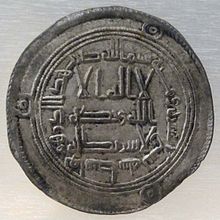Hishām ibn ʿAbd al-Malik
Hishām ibn ʿAbd al-Malik ( Arabic هشام بن عبد الملك, DMG Hišām ibn ʿAbd al-Malik * 691 ; † 743 ) was the tenth and last important caliph of the Umayyads (724–743).
Life
In 724 Hisham took over the rule from his brother Yazid II (720-724). He tried to strengthen the dynasty by expanding the army and the security service. He also strengthened the power of the caliph by removing the tax administration from the governors in the provinces and subordinating them to separate tax directors.
The long reign of Hisham enabled an active foreign policy towards Byzantium , which was attacked in Anatolia by several campaigns. Ultimately, however, Byzantium was able to defeat the attackers ( Battle of Akroinon , 740). After a successful campaign under Marwan against the Khazars (735-737) they had to submit to the Umayyads and cease hostilities. However, the empire was also shaken by several uprisings. In addition to the Maysara uprising in the Maghreb (739–741), there were uprisings by the Shiites in Iraq (740) and tax revolts by the Copts in Egypt (725).
In addition to these unrest, the opinion spread among Muslims that only descendants of the Prophet Mohammed can occupy the office of caliph. In the absence of such family legitimation, this teaching became a threat to the existence of the Umayyads. Therefore attempts were made to suppress the propaganda of the Abbasids (descendants of al-Abbas, an uncle of the Prophet Mohammed ), but this did not succeed in the long run.
buildings
Despite these problems, Hisham was able to consolidate the Umayyad dynasty again and initiate extensive construction work. Agriculture was promoted through the expansion of the irrigation systems in Egypt , Syria and Iraq, and several desert castles were built. These included his palace residence in the Syrian desert and the great mosque in Resafa , which was called Resafa-Hisham in his time , the desert castles of Qasr al-Heir al-Gharbi and Qasr al-Heir al-Sharqi in the desert of Syria and two palaces on South bank of the Euphrates opposite ar-Raqqa , also Chirbat al-Mafdjar in the Jordan Valley near Jericho .
Emirate of Cordoba
After the death of Hisham, the rapid decline of the dynasty began under his successor al-Walid II (743-744). After the Umayyads were overthrown by the Abbasids, one of Hisham's grandsons, Abd ar-Rahman I, founded the Emirate of Córdoba in Al-Andalus . This enabled the Umayyad dynasty to continue in this part of the Islamic world until 1031.
literature
- Claude Cahen : Islam 1. From the origin to the beginnings of the Ottoman Empire . Fischer, Frankfurt am Main et al. 1968, ( Fischer-Weltgeschichte 14).
- Ulrich Haarmann : History of the Arab World . Edited by Heinz Halm . 4th revised and expanded edition. Verlag CH Beck, Munich 2001, ISBN 3-406-47486-1 , (Beck's historical library) .
- Gernot Rotter : The Umayyads and the Second Civil War. (680-692). Steiner, Wiesbaden 1982, ISBN 3-515-02913-3 , ( Treatises for the customer of the Orient 45, 3).
- JJ Saunders: A history of Medieval Islam. Routledge & Paul, London 1965, ISBN 0-7100-2077-5 , (Also: Reprint. Routledge, London et al. 1990, ISBN 0-415-05914-3 ).
- Julius Wellhausen : The Arab Empire and its fall . Reimer, Berlin 1902, (reprint: 2nd unchanged edition. De Gruyter, Berlin 1960).
| predecessor | Office | successor |
|---|---|---|
| Yazid II. | Umayyad Caliph 724–743 |
al-Walid II. |
| personal data | |
|---|---|
| SURNAME | Hishām ibn ʿAbd al-Malik |
| ALTERNATIVE NAMES | Hisham |
| BRIEF DESCRIPTION | Umayyad Caliph |
| DATE OF BIRTH | 691 |
| DATE OF DEATH | 743 |
